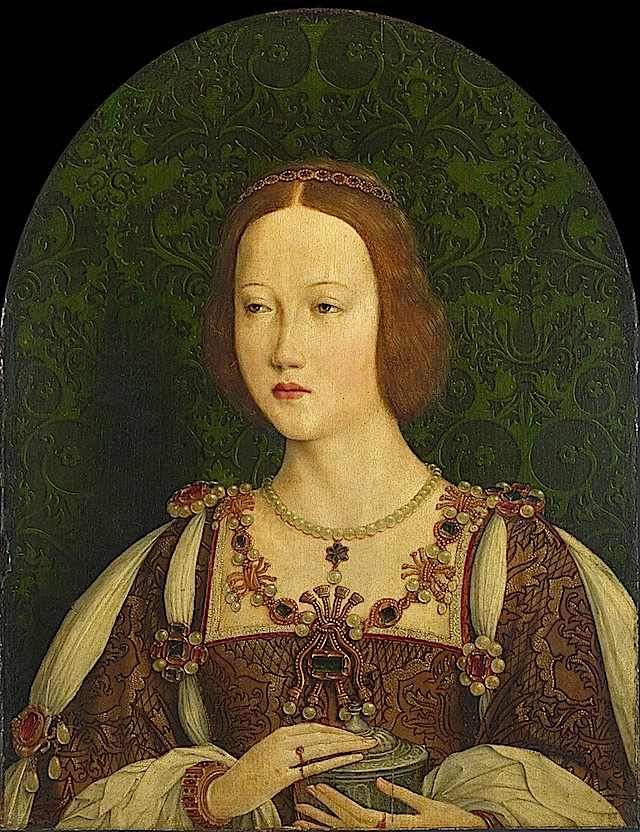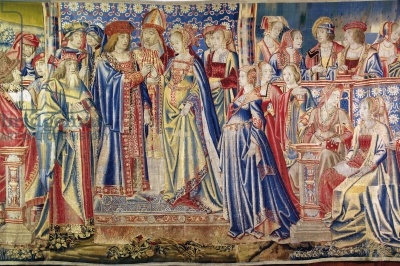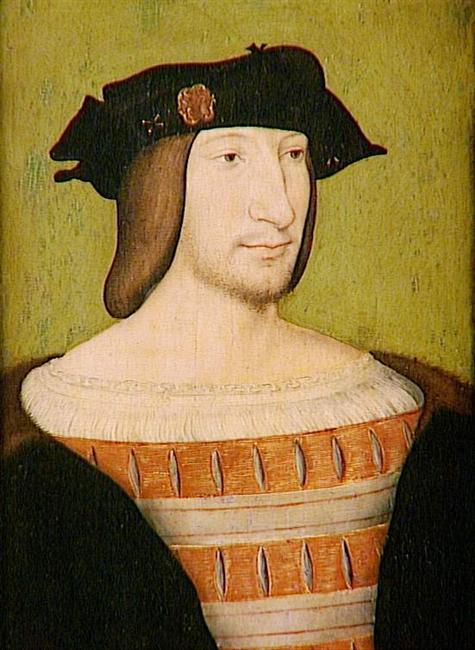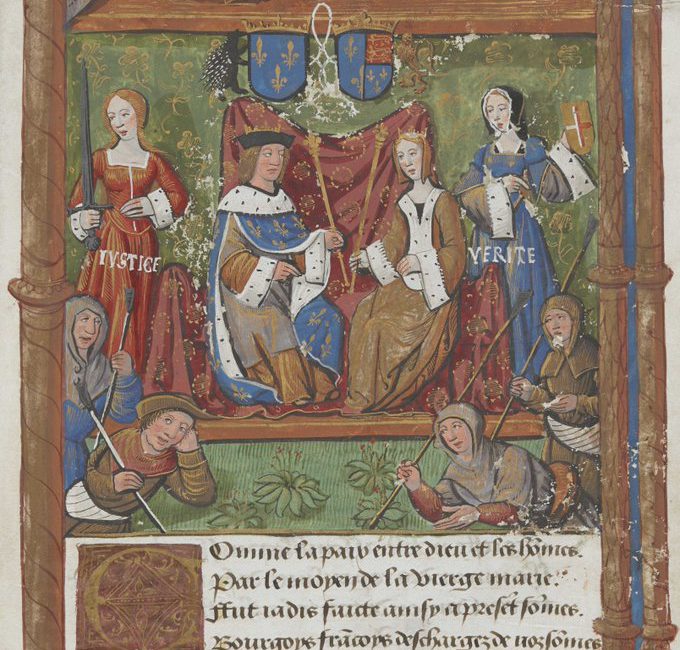On the 13th of August 1514, Princess Mary Tudor was married to King Louis XII of France by proxy at Greenwich Palace. A young and beautiful maid became the wife of an ailing and old monarch! Mary was eighteen, while Louis was fifty-two! However, the age difference did not matter at all: in Tudor period, women – even princesses of the blood – were not mistresses of their own fates, being mere pawns of their ruling relatives in the European marriage market.
Princess Mary Tudor, daughter of Henry VII and sister of Henry VIII
David Loades, a biographer of Princess Mary Tudor, describes her:
“She {Mary} had inherited her mother’s delicate features, belying the passion, willfulness, and charisma that were the legacy of her father’s Tudor ancestors.”
England’s campaign against France of 1512-14 was not a success for King Henry due to the failure of the ruler’s alliance with Ferdinand of Aragon, his father-in-law. As a result, Cardinal Thomas Wolsey, who was beginning his rise to power, negotiated a peace treaty between the two kingdoms. According to this document, the Valois King Louis XII would take Henry’s younger sister, Mary, as his consort, and England would keep the captured city of Tournai.

For Henry VIII, it was a way to establish a new alliance with the continental power. For Louis XII, it was his last attempt to sire a male heir, for his first two wives (Joan of France and Anne of Brittany) failed to give him a healthy son. It was assumed that Mary had to do her duty to England and her sovereign brother. And it was exactly how Mary acted: she complied with Henry’s orders with humility and grace befitting her royal station. For the outside world, it looked as though the woman was obeying what the Lord commanded her to do through her royal brother, for back then kings were considered God’s representatives on earth. Mary’s motto ‘To do God’s will is enough for me’ summed up her personal situation in a sad and rather ironic way.
At the time, Mary seems to have been already infatuated with Henry’s boyhood friend – Charles Brandon, who had recently been elevated to Duke of Suffolk. Correspondence between Mary and Henry of the period shows that her brother was aware of her real feelings, and that she agreed to marry Louis for a special reason. It could have happened like this: Mary could plead with Henry in private not to force her into the marriage to Louis, and in response he could have promised what she wanted to get, or she could have told him that she would enter into this matrimony only if he gave her his word that her next husband would be of her own choosing.
Whatever the case was, Henry got what he needed – Mary’s consent. Did his sister make a deal with him? If that was so, then it was quite an opportunistic step for her, especially given her youth and her lack of experience in life and politics. Anyway, there was a calculation on her part: Mary must have hoped that she would outlive the aging Valois ruler. After all, it was well known that the aging Louis suffered from a severe gout, a skin condition, and other illnesses; according to contemporary sources, during the Anglo-French war in 1513, the King of France once had to be carried to the battlefield in a carriage. How could Louis live for long, then?
Why did Henry give Mary this promise? Most likely, the monarch knew that he would never approve of the match. He was certain that she would not dare go against his kingly will, underestimating her boldness and willfulness. However, Henry was mistaken on this occasion: Mary would have a clandestine marriage to Charles Brandon in France soon after Louis’ death, but it would be her only act of defying her brother’s commands.

During her wedding in England, Mary Tudor was reported to be composed and even radiant. Her joyfulness was noted by the Venetian ambassador Nicolo di Favri and perhaps by other foreign diplomats, who must all have wondered why the king’s sister was oddly exhilarated. According to di Favri, Mary walked down the aisle with an enigmatic smile on her face. They could not know anything about Henry’s secret promise to Mary!
After the ceremony and the nuptial Mass, grand festivities followed. Then the official bedding ceremony took place. After changing into her nightclothes, Mary was escorted to a bedroom, where a magnificent bed had been prepared. She lay down on the bed, with one leg bared to her thigh. As her husband was in France, his subject – Louis I d’Orléans, Duke de Longueville – represented him and married Mary by proxy. Fully dressed, the Duke Longueville arrived at the new Queen of France’s bedchamber, where he removed his hose and bared a leg, touching Mary with it. That was enough to declare Mary’s marriage to Louis XII valid and consummated, rendering the union indissoluble.
Mary was not in excitement, hiding her disgust with her union. She did not wish to see her new husband, who was charmed with her and bombarded her with letters and many expensive gifts. Instead, Mary was biding her time until she was able to enjoy the heady aroma of freedom that would come after Louis’ death. Could she be called a calculative and conniving woman? To answer this question, we have to imagine what a young lady feels if she is compelled to marry a man who is more than thirty years older. Could someone blame Mary for her resolve to hold Henry to his word and just wait? Perhaps, but it would be better not to judge her.
Mary traveled from Dover to Boulogne on the 2nd of Oct 1514, after waiting weeks for stormy weather to improve. Upon her departure, she reminded her brother, King Henry, of his promise about her future. There were 14 ships in Mary’s retinue, but the weather was so terrible that only 4 reached port on time, with the rest having been docked at other ports on the French coast. Suffering from seasickness and constant rain, Mary was carried ashore, and her journey continued. Her mood must have been black when she journeyed from Montreuil to Abbeville.

Mary’s marriage was solemnized on the 9th of October 1514, when Princess Mary Tudor married King Louis XII of France at Abbeville in northern France. She became the Queen of France, but she did not want to be Louis’ wife. She was one of the few English princesses who held that title before her, except for Eadgifu of Wessex who had married Charles III, called the Simple or the Straightforward, almost five hundred years before Mary’s wedding day. According to the witnesses of the wedding in person, Mary was solemn, while the old Louis was joyful that he was now tied to such a young and beautiful creature that could provide him with a son
In a letter to Italy, dated the 10th of October 1514, the Venetian ambassador described:
“Then followed the Queen, under a white canopy, above and around which were the roses, supported by two porcupines. She was alone beneath it, and Monseigneur [d’Angoulême] on her left hand, but outside. She rode a white palfrey, with rich trappings, and was herself clad in very handsome stiff brocade.
Next came her litter, very beautiful, adorned with lilies; then five of the principal English ladies, very well dressed; then a carriage of brocade, on which were four ladies, followed by a second carriage with as many more ladies. Next came six ladies on horseback; and then a third carriage, of purple and crimson velvet (veluto paonazo cremesin), with four ladies; after which a crowd of ladies, some twenty in number; then 150 archers in three liveries. In this order they went to the Queen’s house, which was near that of the King. It was a sumptuous entry, and these noblemen of England have very large chains, and are otherwise in good array.
Before the entry there was a heavy shower, which drenched them all, especially the ladies. The Queen was dressed in the English fashion. In the evening, “Madame,” the King’s daughter, wife of Monseigneur dAngoulême, went to visit her, and they gave a ball. This morning the King had preparation made for the mass in his own hall (salla), whither the Queen came, preceded by 73 (sic) English barons and gentlemen; the King doffed his bonnet, and the Queen curtseyed to the ground, whereupon his Majesty kissed her. The treasurer Robertet then presented to the King a necklace, in which were set two beautiful jewels, and his Majesty placed it round the Queen’s neck; after which mass was performed.”

We know that François d’Angoulême, who had long been proclaimed Louis XII’s heir, attended this wedding together with his cousin-wife – Claude, the eldest daughter of Louis XII and his second wife, Anne de Bretagne. François was a vain and yet gallant man, one who had impeccable manners, but neither he nor his formidable mother, Louise de Savoy, wanted to see the English beauty married to the aging Louis. They feared that she would be able to produce a son with Louis, which would prevent François from ascending to the French throne. History would put everything into place: Mary Tudor would regain her freedom in about 3 months after the ceremony when Louis would die on the 1st of January 1515, while François would become the King of France.
All images are in the public domain.
Text © 2019 Olivia Longueville





